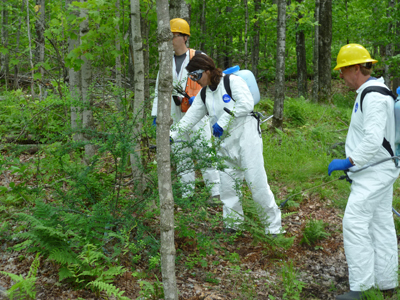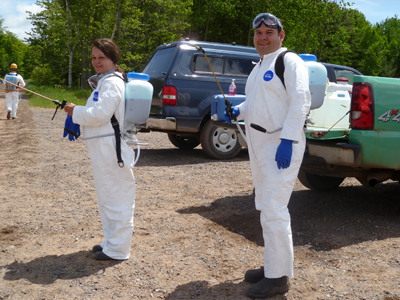Invasive Plant Species
Monitoring and Control
 Anishinaabe people have traditionally harvested plants for food, ceremony, medicines, dyes, tools, construction, and basketry. KBIC's Integrated Resource Management Plan (IRMP) sets forth goals of protecting and expanding stands of culturally significant native plants (i.e. wild rice) and identifying and controlling invasive species on the Reservation that threaten the existence of our native plants. GLRI assistance and assistance from BIA programs provided sufficient support for KBIC to establish a Plant Technician position and provide training to help us meet the goals established in the IRMP. In 2012 additional Technicians were hired using assistance from BIA-GLRI program funds. Objectives of the invasive and native plant program at KBIC include:
Anishinaabe people have traditionally harvested plants for food, ceremony, medicines, dyes, tools, construction, and basketry. KBIC's Integrated Resource Management Plan (IRMP) sets forth goals of protecting and expanding stands of culturally significant native plants (i.e. wild rice) and identifying and controlling invasive species on the Reservation that threaten the existence of our native plants. GLRI assistance and assistance from BIA programs provided sufficient support for KBIC to establish a Plant Technician position and provide training to help us meet the goals established in the IRMP. In 2012 additional Technicians were hired using assistance from BIA-GLRI program funds. Objectives of the invasive and native plant program at KBIC include:
-
Creating an inventory of plant species on reservation lands (native and non-native)
-
Promotion of native plant use,
-
Management of culturally significant plants,
-
Control of invasive plant species, and
-
Creation of wildlife habitat through native species restoration (see section on Sand Point Wildlife Habitat Restoration).
Control Methods
-
Manual/Mechanical
-
Pulling/Digging
-
Mowing
-
Cutting
-
Girdling
-
Fire/burning
-
-
Chemical
-
Herbicides
-
-
Biological
-
Insects (beetles/weevils)
-
Fungi
-
Note: KBNRD prefers to use manual/mechanical and biological control whenever possible. Chemical control is only used when other control methods have not been successful.
Current Activities
To date, control efforts have focused on four invasive species on Reservation lands: purple loosestrife, Japanese barberry, spotted knapweed, and Eurasian watermilfoil. Active control as well as locating and mapping locations of invasive plants for future control has been a high priority for our plant program staff. KBIC is also working in collaboration with a number of groups and agencies on invasive control efforts and native seed collection and propagation, including Great Lakes Indian Fish and Wildlife Commission (GLIFWC), U.S. Forest Service (USFS), Midwest Invasive Plant Network, Baraga County Conservation District, and others.
 What can you do to help?
What can you do to help?
-
Stick to native plant species when landscaping around your property. For example, plant a sugar or red maple instead of the ornamental Norway maple to beautify your yard.
-
Encourage use of native plant seed for roadsides and ditches
-
Remove all invasive/non-native species from your property
-
Plant native species for livestock feed
-
Properly clean boats and lawn equipment before and after use
Partnerships & Collaborations
The following agencies and organizations (in addition to KBNRD) represent a collaborative effort to combine resources and skills to help protect our natural resources from invasive species in Baraga county.
- Rip-It-Up
- U.S. Forest Service (USFS)
- Baraga Conservation District
- Michigan Department of Natural Resources (MDNR)
- Keweenaw Invasive Species Management Association (KISMA)
- Cedar Tree Institute
- Great Lakes Indian Fish and Wildlife Commission (GLIFWC)
- Midwest Invasive Plant Network (MIPN)
- Superior Watershed Partnership
Additional Resources
-
Great Lakes Indian Fish & Wildlife Commission: http://invasives.glifwc.org/
-
Michigan Department of Natural Resources: http://michigan.gov/dnr/0,4570,7-153-10370_59996---,00.html
-
U.S. Forest Service: http://www.fs.fed.us/publications/policy-analysis/invasive-species-position-paper.pdf
-
Rip-It-Up: http://www.uprcd.org/uprcd3157921.asp
-
Cedar Tree Institute: http://cedartreeinstitute.org/
-
Midwest Invasive Plant Network: http://mipn.org/
